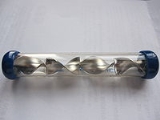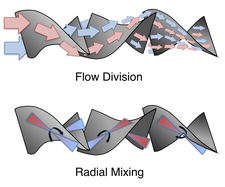
Static mixer
Encyclopedia
A static mixer is a device for mixing two fluid materials. Most commonly, the fluids are liquid; however, static mixers are used to mix gas streams, disperse gas into liquid or disperse immiscible liquids. The device consists of mixer elements contained in a cylindrical (tube) or squared housing. These can vary from about 6 mm to 6 meters diameter. Static mixer elements consist of a series of baffles that are made from metal
or a variety of plastics. Similarly, the mixer housing can be made from metal or plastic. Typical materials of construction for the static mixer components included stainless steel
, polypropylene
, Teflon, PVDF and polyacetal.
The overall system design incorporates a method for delivering two streams of liquids into the static mixer. As the streams move through the mixer, the non-moving elements continuously blend the materials. Complete mixing is dependent on many variables including the fluid properties, tube inner diameter, the number of elements, and their design.

 A static mixer's fixed, typically helical, elements can simultaneously produce patterns of flow division and radial mixing:
A static mixer's fixed, typically helical, elements can simultaneously produce patterns of flow division and radial mixing:
) and sealants (see Resin casting
). Other applications include wastewater treatment
and chemical processing. Static mixers can as well be used in the refinery and oil and gas market, for example for the desalting of crude oil. In the polymer production static mixers can be used for polymerization reactions or for the admixing of liquid additives.
. This device was licensed to the Kenics Corporation and marketed as the Kenics Motionless Mixer. Today, the Kenics brand is owned by Robbins & Myers, Inc.; however, there are also other suppliers of static mixers, including Sulzer Chemtech Ltd, Koflo Corporation, Statiflo and KOMAX Systems Inc.
Metal
A metal , is an element, compound, or alloy that is a good conductor of both electricity and heat. Metals are usually malleable and shiny, that is they reflect most of incident light...
or a variety of plastics. Similarly, the mixer housing can be made from metal or plastic. Typical materials of construction for the static mixer components included stainless steel
Stainless steel
In metallurgy, stainless steel, also known as inox steel or inox from French "inoxydable", is defined as a steel alloy with a minimum of 10.5 or 11% chromium content by mass....
, polypropylene
Polypropylene
Polypropylene , also known as polypropene, is a thermoplastic polymer used in a wide variety of applications including packaging, textiles , stationery, plastic parts and reusable containers of various types, laboratory equipment, loudspeakers, automotive components, and polymer banknotes...
, Teflon, PVDF and polyacetal.
The overall system design incorporates a method for delivering two streams of liquids into the static mixer. As the streams move through the mixer, the non-moving elements continuously blend the materials. Complete mixing is dependent on many variables including the fluid properties, tube inner diameter, the number of elements, and their design.
Design


- Flow division: In laminar flowLaminar flowLaminar flow, sometimes known as streamline flow, occurs when a fluid flows in parallel layers, with no disruption between the layers. At low velocities the fluid tends to flow without lateral mixing, and adjacent layers slide past one another like playing cards. There are no cross currents...
, a processed material divides at the leading edge of each element of the mixer and follows the channels created by the element shape. At each succeeding element, the two channels are further divided, resulting in an exponential increase in stratification. The number of striationStriationStriations means a series of ridges, furrows or linear marks, and are used in several ways* Glacial striation* Striation , a striation as a result of a geological fault* In medicine, striated muscle...
s produced is 2n where 'n' is the number of elements in the mixer. - Radial mixing: In either turbulent or laminar flowLaminar flowLaminar flow, sometimes known as streamline flow, occurs when a fluid flows in parallel layers, with no disruption between the layers. At low velocities the fluid tends to flow without lateral mixing, and adjacent layers slide past one another like playing cards. There are no cross currents...
, rotational circulation of a processed material around its own hydraulic center in each channel of the mixer causes radial mixing of the material. Processed material is intermixed to reduce or eliminate radial gradients in temperature, velocity and material composition.
Applications
Today static mixers are established in many different market segments and are used for a wide range of different applications A common application for static mixers includes mixing two component adhesives (e.g. epoxyEpoxy
Epoxy, also known as polyepoxide, is a thermosetting polymer formed from reaction of an epoxide "resin" with polyamine "hardener". Epoxy has a wide range of applications, including fiber-reinforced plastic materials and general purpose adhesives....
) and sealants (see Resin casting
Resin casting
Resin casting is a method of plastic casting where a mold is filled with a liquid synthetic resin, which then hardens. It is primarily used for small scale production like industrial prototypes and dentistry...
). Other applications include wastewater treatment
Sewage treatment
Sewage treatment, or domestic wastewater treatment, is the process of removing contaminants from wastewater and household sewage, both runoff and domestic. It includes physical, chemical, and biological processes to remove physical, chemical and biological contaminants...
and chemical processing. Static mixers can as well be used in the refinery and oil and gas market, for example for the desalting of crude oil. In the polymer production static mixers can be used for polymerization reactions or for the admixing of liquid additives.
History
The static mixer traces its origins to an invention for a Mixing Device filed on Nov. 29, 1965 by the Arthur D. Little CompanyArthur D. Little
Arthur D. Little is an international management consulting firm originally headquartered in Boston, Massachusetts, United States, and formally incorporated by that name in 1909 by Arthur Dehon Little, an MIT chemist who had discovered acetate. Arthur D. Little pioneered the concept of contracted...
. This device was licensed to the Kenics Corporation and marketed as the Kenics Motionless Mixer. Today, the Kenics brand is owned by Robbins & Myers, Inc.; however, there are also other suppliers of static mixers, including Sulzer Chemtech Ltd, Koflo Corporation, Statiflo and KOMAX Systems Inc.

